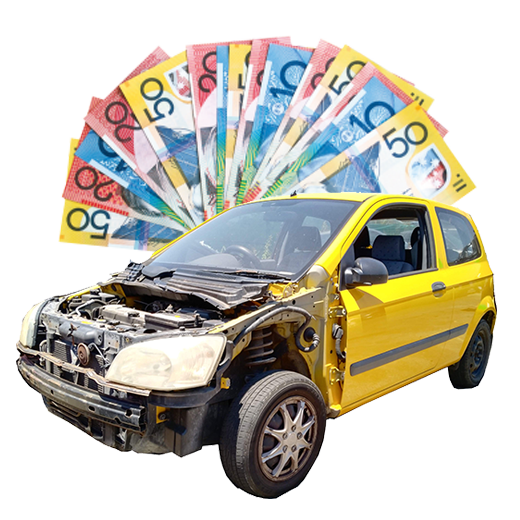Got an old car that's seen better days? Selling it for parts can be a fantastic way to squeeze every last dollar out of it, especially if it's been in a prang, won't start, or happens to have some really desirable components.
Instead of taking a lowball offer for the whole vehicle, breaking it down lets you sell the good bits individually. Sure, it takes a bit more elbow grease, but the payoff can be well worth it.
Is Parting Out Your Car Actually Worth It?
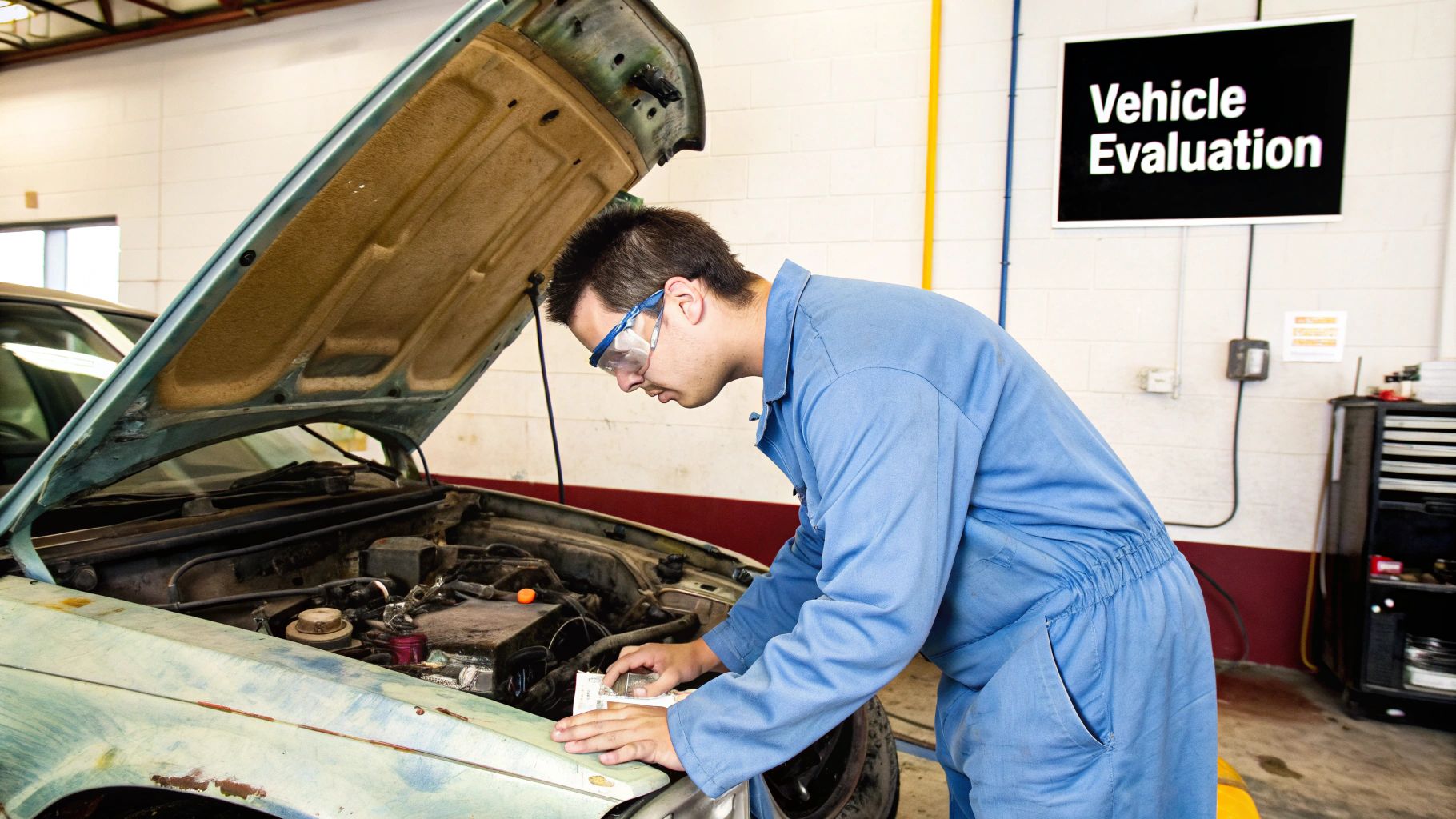
Before you even think about reaching for the spanners, you need to have an honest chat with yourself: is selling your vehicle for parts really the best move? Not every car is a treasure trove of components. The real value is in finding that sweet spot between your car's condition and the time you're willing to put in.
Let’s look at a classic Adelaide situation. Say your old Holden Commodore has copped a fair bit of panel damage, making it too pricey to fix and a tough sell. But, its V8 engine and transmission are running sweet with low Ks. In a case like this, the car is almost certainly worth more in pieces than as a complete, damaged unit.
When Does Parting Out Make Sense?
This approach isn't a one-size-fits-all solution. It works best in a few key scenarios. If your car fits one of these descriptions, you could be onto a winner:
- It has high-demand components: Your car might have a sought-after engine, gearbox, or other specialty parts that are in great nick. Think performance models, 4x4s, or reliable old workhorses.
- It's a rare or classic model: Enthusiasts often struggle to find original parts for older or less common cars. Your bits and pieces could be exactly what they need to finish a project.
- The damage is just cosmetic: The body might look a bit rough, but if the engine, drivetrain, and electronics are all sound, you've got a great candidate.
Here's the question you need to ask: "Can I make significantly more money selling the top 3-5 parts than I would selling the whole car to a wrecker?" If the answer is a clear yes, then it's a project worth tackling.
Weighing Up the Profit vs. the Effort
The easy way out is always a quick sale to an auto removal service. Parting out a car, on the other hand, requires a place to work, the right tools, and a serious time commitment. You have to balance the potential for a bigger payout against the sheer convenience of a one-and-done deal.
A smart first step is to figure out your car's basic scrap value. This gives you a baseline to compare against. Doing a bit of research on the factors that determine your scrap vehicle value will give you the clarity you need to make a solid financial choice.
How to Figure Out What Your Car's Parts Are Really Worth
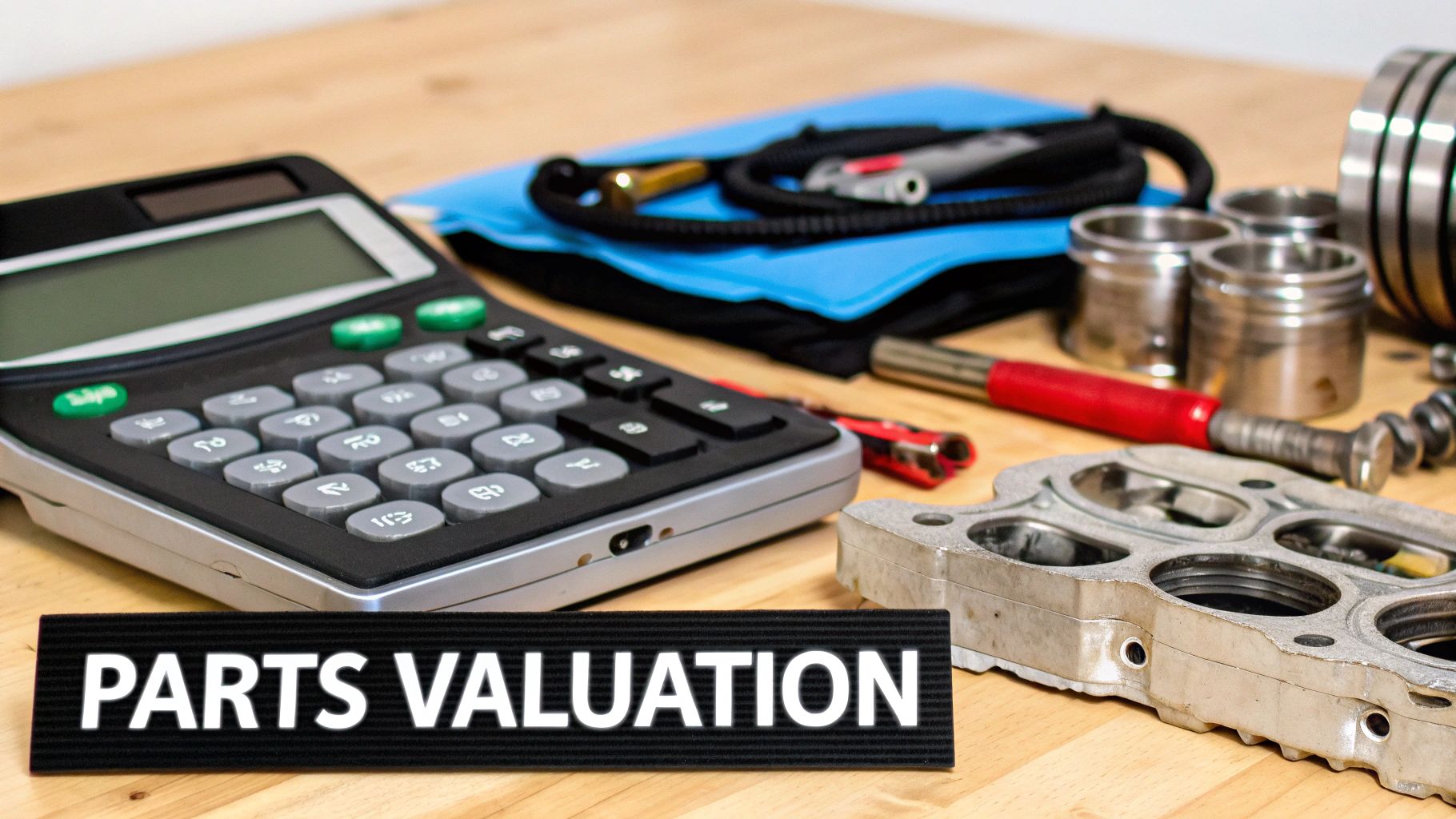
Knowing what your car’s individual pieces are worth is the difference between a profitable project and a frustrating waste of time. When you decide to sell a vehicle for parts, you’re essentially running a small business, and that means accurate pricing is everything. Don’t just guess at the value; a bit of smart research will pay you back in spades.
Of course, the big-ticket items are usually the engine and transmission, especially if they’re in good nick with low, verifiable kilometres. But don't sleep on the smaller treasures. Things like catalytic converters, engine control units (ECUs), alternators, and even complete airbag modules can fetch surprisingly good money. You're tapping into a massive market here—the Australian auto parts aftermarket is a multi-billion dollar industry that's only expected to grow by 2033 as the cars on our roads get older. Learn more about the Australian auto parts aftermarket trends.
Researching the Local Adelaide Market
Your best bet for pricing is to go where the buyers are. Spend some real time browsing local online marketplaces like Gumtree and Facebook Marketplace. You want to be looking for parts from the exact same make and model as your car.
Look at how other people are listing their items. What condition are they in? Are part numbers included? What’s the asking price? This kind of real-world data is far more useful than any generic online estimate.
- Engine & Transmission: Search for your specific engine code and transmission type. You’ll see that prices can swing by over $1,000 depending on the kilometres and overall condition.
- Body Panels: Try to find panels in the same factory colour as yours. A straight, undented door in a popular colour will always sell for more than one that needs a trip to the panel beater.
- Wheels & Tyres: Check the brand, size, and how much tread is left. A clean set of genuine alloy wheels with decent rubber is way more appealing than a set of scuffed-up steelies with bald tyres.
Below is a quick reference guide to give you a ballpark idea of what some common parts can go for in the Australian market. Remember, these are just estimates—your own research will give you the most accurate figures for your specific parts.
Estimated Value of High-Demand Car Parts
| Part | Condition | Estimated Value Range (AUD) |
|---|---|---|
| Complete Engine | Good, low km | $800 – $2,500+ |
| Transmission (Automatic) | Good, working | $500 – $1,500 |
| Catalytic Converter | Intact, OEM | $150 – $800+ |
| Alloy Wheel Set (with tyres) | Good, minimal rash | $300 – $1,000 |
| Headlights (pair) | Clear, no cracks | $100 – $400 |
| Alternator / Starter Motor | Working | $50 – $150 |
| Car Doors (each) | Good paint, no dents | $100 – $350 |
These values can shift based on rarity and demand, so always check what similar items are currently listed for in Adelaide.
Create an Inventory to Maximise Your Profit
Once you have a handle on the values, it’s time to get organised. A simple spreadsheet is your best friend here. For every major part you plan to sell, log its condition, any part numbers you can find, and the competitive price you’ve researched.
This isn’t just about tracking your potential income; it’s about empowering you when it comes time to negotiate.
A detailed catalogue is your negotiation playbook. When a buyer makes an offer, you'll know instantly whether it's a fair price or a lowball attempt, because you've already done the homework.
Taking the time to do this might feel a bit tedious, but it's the surest way to get top dollar for your car's components. If you'd like a quick starting point for your car's overall value before you begin, our simple junk car value calculator can give you a helpful baseline.
Getting Your Hands Dirty: The Smart Way to Dismantle Your Car
Alright, you've figured out what your car parts are worth and you've got a game plan. Now for the fun bit – taking it all apart. But hold on. This isn't about just grabbing a sledgehammer; it’s a careful, methodical process.
Before you even think about loosening a single bolt, make sure your toolkit is up to the task. You absolutely need a good socket and spanner set, a variety of screwdrivers and pliers, a reliable jack, and, most importantly, a set of sturdy axle stands. Safety isn't negotiable here.
Thinking about pulling the engine or transmission? Don't even try it without an engine hoist. You can hire one for a reasonable price, and it's the only safe way to handle those massive components. Trust me, it’s a small investment to protect both yourself and the valuable parts you’re trying to sell.
The Right Way to Take It Apart
There’s a bit of an art to disassembly. I've found the best way is to work from the outside in. This stops you from having to lean over loose bits and pieces, which saves a heap of time and frustration.
- Start with the Interior: Jump inside the cabin first. Get the seats, centre console, dashboard bits, and stereo out. These are generally easier to remove and often find buyers pretty quickly.
- Move to the Exterior: Next up, the body panels. Carefully unbolt the doors, bonnet, boot lid, and bumpers. Getting these off clears a huge amount of space, giving you much better access to everything else.
- Tackle the Engine Bay Peripherals: Before you even look at the engine, disconnect the battery. Then you can start removing the radiator, alternator, air-con compressor, and starter motor.
This infographic breaks down a simple workflow for getting your parts identified, removed, and ready to list.
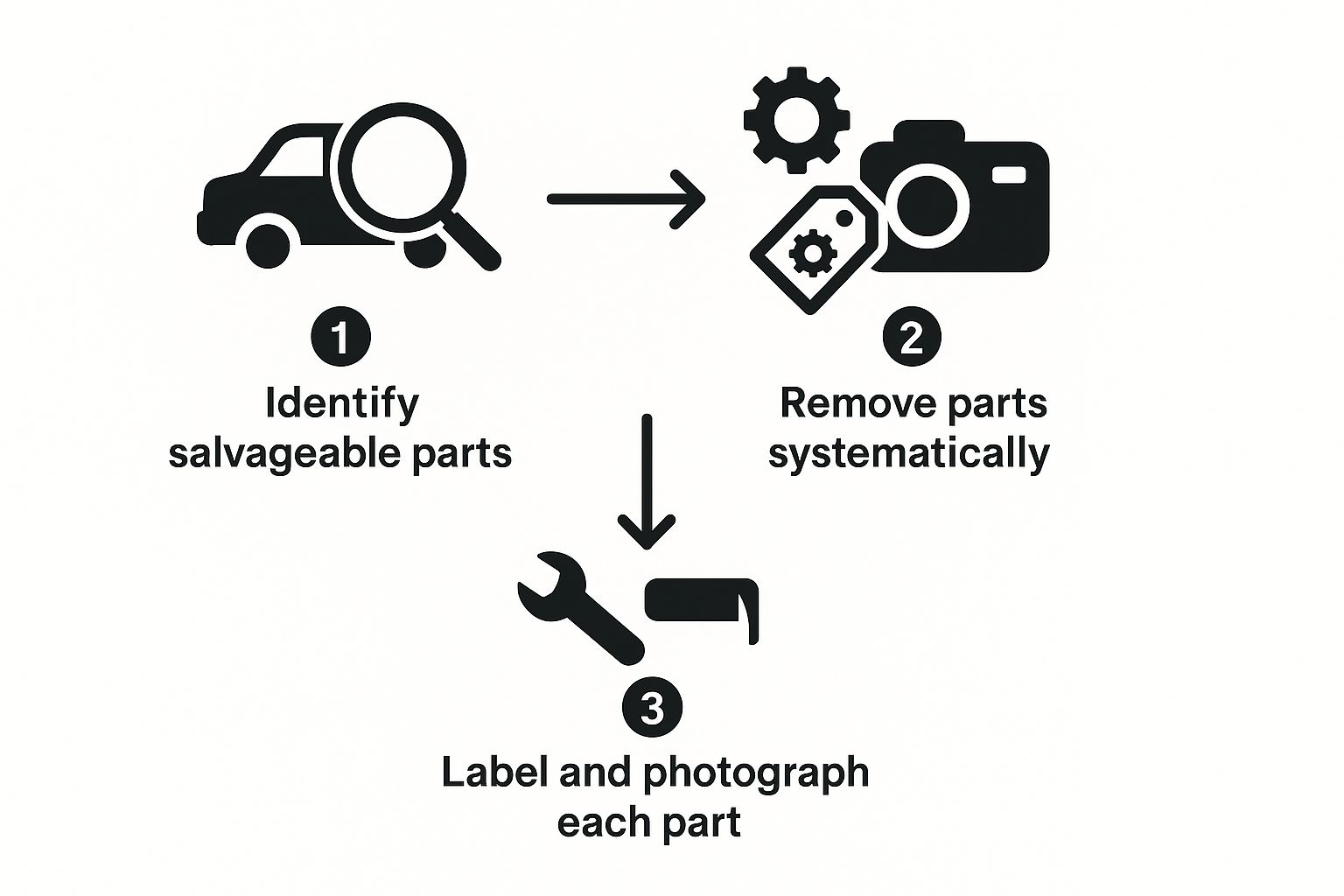
Following a system like this makes the job feel less overwhelming and ensures you don't forget any valuable bits.
Staying Safe and Organised
First thing's first: drain all the fluids. We're talking oil, coolant, brake fluid, and whatever fuel is left. Use proper containers and, please, dispose of them responsibly. It’s not just about your safety; it's about not harming the environment, and there are regulations around this stuff.
When it comes to tricky components like airbags, always disconnect the battery and then wait at least 30 minutes before you touch them. This gives the system time to discharge, preventing a nasty surprise.
Here's a pro tip: As you take each part off, label it straight away. A simple tag or even a permanent marker will do. Jot down what the part is, the car it came from (model and year), and a quick note on its condition. This little habit will save you a world of pain later when people start calling with questions.
A bit of organisation goes a long way. From handling fluids safely to keeping your parts labelled, a methodical approach makes the whole process smoother. If you want to learn more about doing things by the book, take a look at our guide on automotive parts recycling.
Creating Online Listings That Actually Sell
Alright, you've done the hard yards and your garage is now an organised collection of labelled parts. The next step is turning that collection into cash, and how you present everything online is what makes or breaks a sale.
For anyone selling in Adelaide, your go-to platforms are going to be Facebook Marketplace and Gumtree. They're crawling with local DIY mechanics and car lovers who are actively looking for what you've got.
Success on these sites isn't complicated. It really boils down to creating a listing that's easy to find and easy to trust. Your title is the first thing people see, so make it count. Think like someone who needs your part – what are they typing into that search bar?
A great title is specific. It should include the part name, the car's make, model, and year. For instance, "Ford Falcon FG Right Front Guard" is a world away from a vague "car parts for sale" and gets you in front of the right buyer instantly.
Crafting a Description That Builds Trust
When you're writing the description, just be straight up. Honesty is your best asset here. Clearly point out the part's condition, including any scuffs or normal wear and tear. If you can find the part number, definitely include it. That one little detail is gold for a serious buyer, as it lets them confirm it's exactly what they need and shows you've done your homework.
Remember, you're not just offloading a piece of metal – you're providing the perfect solution for someone's project or repair. This shift to online selling is massive in Australia. In fact, the vehicle parts eCommerce market down under is expected to pull in around US$1,012 million this year alone.
The golden rule for a great listing is to give a buyer every single piece of information they need to say "yes" without having to send you a message. That means killer photos, an honest description, and a fair price.
And speaking of photos, they are absolutely non-negotiable. You don't need a professional setup; the camera on your phone will do the job perfectly well. The key is to take clear, well-lit photos from every possible angle.
If you really want to make your parts pop and build that instant trust, it's worth learning how to take professional product photos for your listings. A bit of extra effort on the visual side can make all the difference, helping you sell faster and for a better price.
Juggling Buyers and Closing the Deal Safely
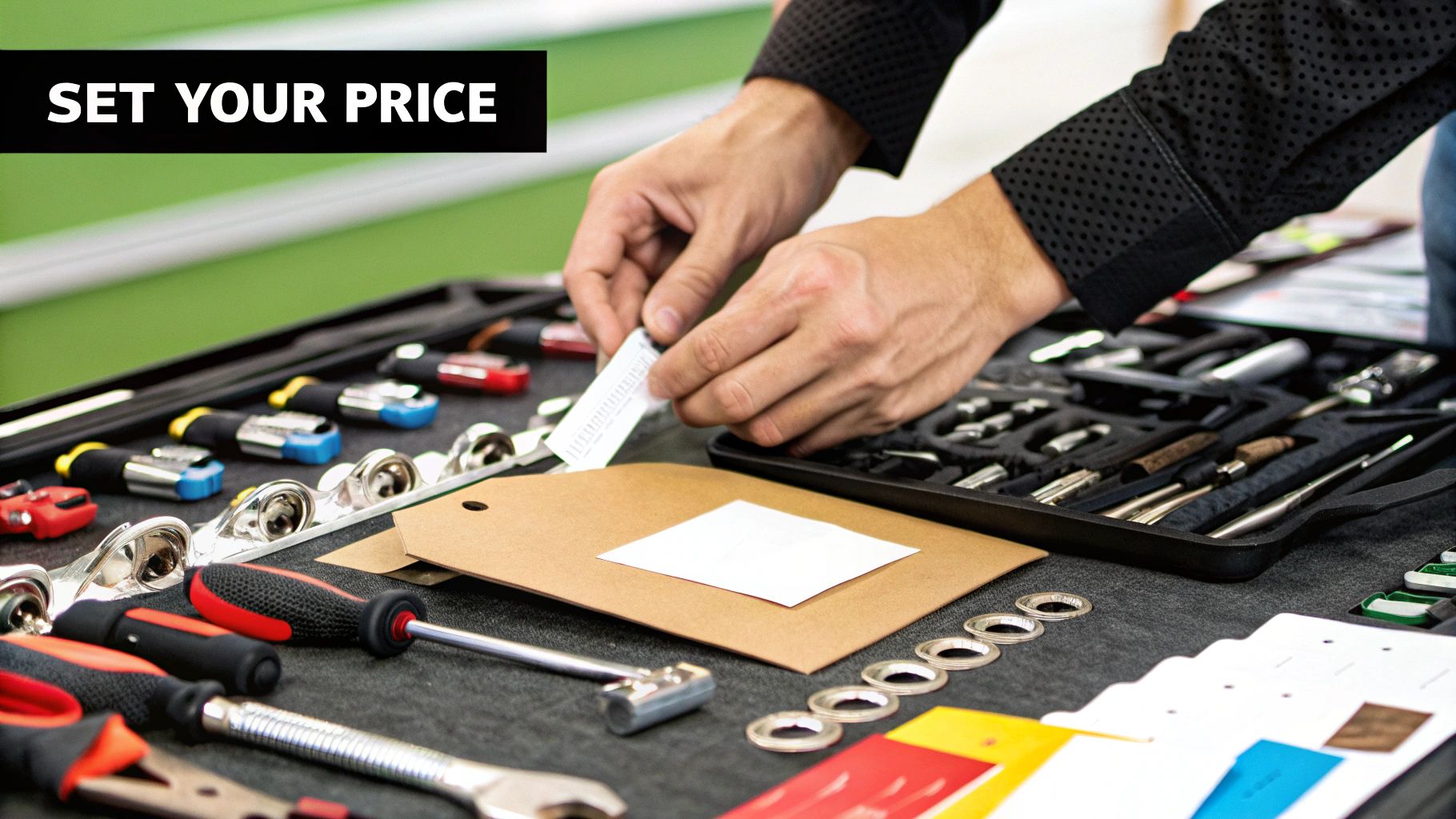
Alright, your parts are listed. Now comes the interesting part: dealing with people. When you're selling a vehicle for parts, you'll need a bit of patience and a good knack for spotting the genuine buyers from the time-wasters. Expect a flood of lowball offers and questions you've already answered in the description. The trick is to be polite but firm, always pointing back to the fair price you've already researched.
You'll almost certainly get the classic "I can pick it up today for half your asking price" message. Don't let it faze you. A serious buyer who actually needs that part will understand its value and respect your price.
Keep in mind that the private resale market is a huge contributor to Australia's motor vehicle repair sector, an industry with a whopping market size of AUD 15.8 billion. There’s real demand for good, used parts, so you don't need to jump at the first low offer. You can find more details on the Australian motor vehicle repair sector on ibisworld.com.
Getting Paid and Organising a Safe Handover
When it's time to talk money, cash is king. Cash on pickup is by far the safest route, as it completely sidesteps online scams, bounced payments, or frustrating chargebacks. Be wary of anyone pushing for complicated payment methods or asking for your bank details before they've even laid eyes on the part.
For the actual handover, safety first. If you can, meet in a busy, public place during the day. If the buyer needs to come to your property in Adelaide to collect a larger part, just make sure you’re not alone.
- For local pickups: Lock in a clear time and have the part ready for inspection.
- For shipping interstate: Never, ever post anything until the payment has fully cleared in your account. Always use a reliable courier service that provides tracking.
Key Takeaway: The job isn't done when the last part is sold. The final step is dealing with the paperwork to make sure the car is officially off your hands and off the road.
Once you’ve sold off all the valuable components, you need to cancel the vehicle's registration. This means filling out and lodging an 'Application to Cancel Vehicle Registration' with Service SA and handing back the number plates. Always get a receipt from the scrap dealer who collects the leftover shell and keep a copy of your cancellation form for your own records. It’s your proof the car is no longer yours.
Common Questions About Parting Out a Car
Even the best-laid plans can leave you with a few nagging questions. When you're looking to part out a car, a few common queries always seem to surface. Getting these sorted out early on can save you a world of trouble down the track and make sure you’re handling things correctly.
Probably the biggest question we hear is what to do with the car's shell once you've pulled off all the good bits. It's not quite as simple as just calling up the local scrap yard.
What Paperwork Is Needed to Scrap a Car in SA After Parting It Out?
After selling off the valuable components, you're left with a bare-bones chassis that needs to be legally taken off the road. In South Australia, you can't just let it disappear; you need to officially let the government know.
This means you’ll have to fill out and submit an 'Application to Cancel Vehicle Registration' form at a Service SA centre. You'll also need to hand in the number plates.
A crucial final step: always, always get a detailed receipt from the scrap metal dealer who takes the shell. This is your proof of disposal and the one thing that protects you if any issues pop up later.
Which Car Parts Bring in the Most Cash?
No surprises here – the engine and transmission are usually the big-ticket items. This is especially true if they're in good working condition and you have records to prove they've got low kilometres on the clock. A solid engine can sometimes fetch more than what you'd get for the entire car from a wrecker.
But don't stop there. Catalytic converters are always in high demand because of the precious metals inside them. You might also be surprised by what some other parts can sell for:
- Alternators and starter motors, provided they still work.
- Intact airbags (just be incredibly careful when handling them).
- Modern infotainment systems, especially touchscreens with GPS.
- A full set of alloy wheels, particularly if the tyres still have some life left.
The real trade-off is this: dismantling the car yourself will nearly always put more money in your pocket, but it's a huge commitment of time, space, and effort. Selling straight to a wrecker is the quick-and-easy path – you get paid on the spot, and they haul it away for you.
If you've got the skills and the weekend to spare, go for it. But if you just want the car gone and cash in hand without the fuss, a professional wrecker is the way to go.
For a hassle-free alternative that puts cash in your hand today, Auto Removal Adelaide offers instant quotes and free car removal across the Adelaide area. Get your free quote now!

